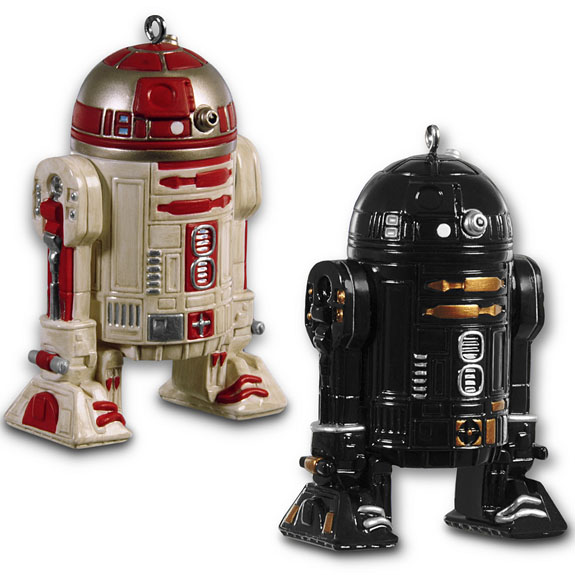As the high-definition format of Blu-ray looks forward to the franchise of
Star Wars: The Complete Saga (Episodes I-VI) hitting its catalogue, it’s time for fans to look back at the historical saga of
Star Wars. With the 70’s, 80’s, 90’s, the dawn of the 21
st century and now the teens of it,
Star Wars
has existed in five decades and counting, but how pure was that first
one. How glorious was that second, how rejuvenating was that third, how
sweet that fourth and the fifth has just started. Before
Star Wars is in high-definition, this is
Star Wars
in retrospect. You’ll need a home theater seat by September 16, but you
don’t need a theater seat to experience this now. No, this is your seat
on the Millennium Falcon and hyperspeed is after the jump.

It is a period six years after Revenge Of The
Sith. Animated spaceships on television, striking along with a plethora
of merchandising and video games, have dominated out of George Lucas’
vast production empire.
During these years marked by Clone Wars, Convention V spies
managed to spread the announcement of the Empire’s ultimate weapon, the
BLU-RAY, a high-definition format with enough power to destroy an entire
Star Wars club.
Pursued by the Empire’s sinister marketing, fans eagerly wait
to race to store shelves, and become custodians of the space opera that
can relieve their anticipations and restore freedom to the HD galaxy….
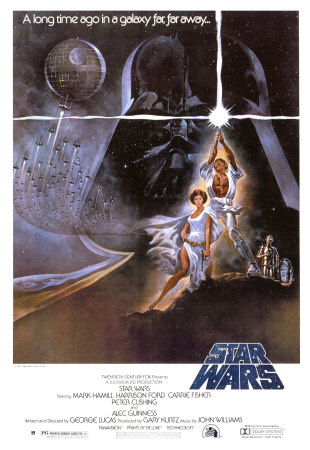
When originally released in 1977, the first
Star Wars film was simply titled:
Star Wars.
It was forbidden for Lucas to use a subtitle to avoid confusion as
there had been no prior films in the franchise and there was no
certainty that there’d be anymore. But indeed, there was another by
1980, one of many to come, that allowed George Lucas to further his
command over
Star Wars and further the success of his business
interests. Lucas’ role became bigger than the writing hat or director’s
chair he occupied with the first film. To allow Lucas to devote himself
to his company, he offered the role of director to Irvin Kershner, one
of his former professors. When
The Empire Strikes Back was released in 1980, the subtitle “
Episode V” appeared above the title card. To match its sequel’s crawl, the subtitle “
Episode IV: A New Hope”
was added for the 1981 re-release of the first film where it continued
to appear throughout the film’s releases and re-releases. The original
version, without the subtitle, was not made available again until the
2006 limited edition DVD. The original was also without the various
enhancements that were added back in the 1990’s after being revamped
with a makeover worth millions in production additions for its
theatrical re-release, modernizing it for a new generation.
So how did
Star Wars come to be? George Lucas got his start
going to school, so maybe it’s not a bad idea to stay in it. He is an
educated man in the discipline of film. His student film in the 1960’s,
Electronic Labyrinth: THX 1138 4EB, was the seed for the development of 1971’s
THX 1138
starring Robert Duvall. The film was made under the umbrella of a new
production company known as American Zoetrope, which had been
established in 1969 by Francis Ford Coppola and George Lucas. While his
student film originally inspired Warner Bros. to award him a student
scholarship to observe and work on the making of a film with Francis
Ford Coppola,
THX 1138 failed to inspire major audiences in 1971.

That changed with
American Graffiti when George Lucas brought his love of cars and his California background to the screen.
American Graffiti
introduced George Lucas to major movie profitability and debuted
Lucasfilm to the world. In 1973, George Lucas took full advantage of the
success he had with
American Graffiti, knowing it might be
hard to get a second chance at a little space opera that could. It
wasn’t easy, though. Knowing what a concept will end up as is a tricky
game. After all, hindsight is always 20/20 and foresight is legally
blind. Studios did pass on
Star Wars. It may have been the scale and it may have all been just too much like
Star Trek for executives. 20
th
Century Fox thought slightly differently. They were willing to take a
chance, especially when they agreed to cut George Lucas’ fee for writing
and directing Star Wars in exchange for giving the director control
over merchandising rights. For 20
th Century Fox, the rights were useless. At least, they were at the time.
So after drafts upon drafts, production went underway on
Star Wars,
the positive and wholesome adventure for all in the family. Aside from
Alec Guinness as Obi-Wan Kenobi, the main cast was made of relative
unknowns lacking any distinguished careers. Because of a recommendation
from Steven Spielberg, George Lucas got John Williams to create what
would become one of the most recognizable soundtracks in history, but
more was needed than a theme song. The film under the guidance of George
Lucas needed unprecedented visual effects. If you can’t find it, make
it yourself. Lucas brought in a youthful team to found Industrial Light
& Magic. If production was a harsh nightmare in the studios and then
out of them in locations like Tunisia, post-production was hell.
Editing of both visual shots and audio clips pushed the limits of
filmmaking. R2-D2 needed a new language. Lightsabers needed their own
unique swoosh and clash. Darth Vader needed a vocal breathing of
villainy. Editing of both visual and audio elements was vital to
Star Wars’
success on the screen, possibly like for no other film before. The
entire movie had to be manufactured. There was hardly anything that
looked or sounded like the real world. Editing gives you many options,
but limitless options are chaotic to grapple.

By
1976, Lucasfilm needed seats to be filled in a year, so personnel
visited Comic-Con in San Diego in hopes of arousing support for their
future movie release. Confidence may not have been at a high, but
pressure was at the boiling point. Then on May 25, 1977, it may as well
have been Judgment Day. This was the day that was to decide everything
that would follow for a project that had ended millions of dollars over
its initial budget. Was all to be nirvana or was all to be Armageddon?
The great risk ended with great rewards. The movie earned back its $11
million cost and then much, much more with hundreds of millions of
dollars in box-office receipts. It sparked a string of recognitions that
the franchise would accumulate over the years, including Academy Awards
and Hugo Awards. 20
th Century Fox ended up with an
international extravaganza to add to its bottom-line, but George Lucas
ended up with a phenomenon in the form of rights. The licensing business
was a disappointing surprise to 20
th Century Fox. The studio
had given the licensing rights and therefore heavenly profits to George
Lucas, but it wasn’t immediate. Sadly, the full extent of merchandising
potential wasn’t capitalized on early, but
Star Wars
merchandising wasn’t going to be dominated by little puzzles and a
top-selling soundtrack for too long. Toys were needed, but to make toys,
a company was needed from the Midwest that had gotten permission to
manufacture them long ago and was just as far away by May 1977. Kenner
didn’t have anything worthwhile available for the movie’s release, so
they pondered and they thought. They had to think fast. Time was of the
essence and they knew exactly how much of it was left. Christmas morning
was seven months away.
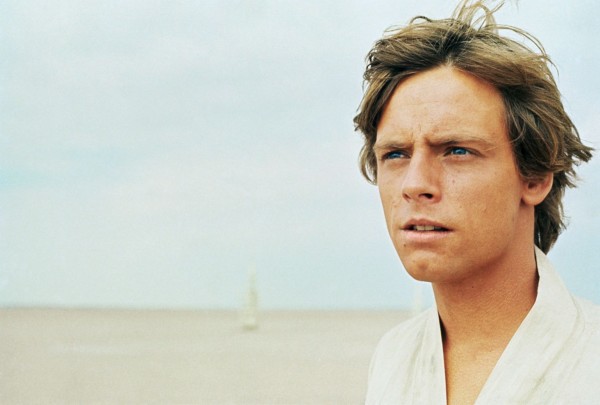
For George Lucas’ immediate pocketbook,
Star Wars
gave him the independent power to champion his causes of investing in
the development of technology for Hollywood. Industrial Light &
Magic is Hollywood’s mega player in digital wizardry for movies across
the spectrum today. Skywalker Sound provides the audio equivalent of
what Industrial Light & Magic does visually. Ever wondered about
that THX image and elongated deep note that come up in front of many
movies? It’s a trade name of a high-fidelity audio reproduction standard
for things like movie theaters, screening rooms, home theaters and
audio systems. For the most part, it’s mainly a quality assurance
system. THX-certified theaters provide a high-quality, predictable
playback environment to ensure that any film soundtrack mixed in THX
will sound just as the original engineers intended. It debuted in 1983
with
Episode VI: Return Of The Jedi. Even
Pixar Animation Studios can trace its roots to Lucasfilm. John Lasseter
left Disney in the 1980’s to work with George Lucas’ computer graphics
division at Lucasfilm. It was bought in 1986 for $10 million by Steve
Jobs. That former division, and now a company, would be named Pixar and
eventually debut the short film
Luxo Jr., which would thus lead to classics years later like
Toy Story,
Finding Nemo,
Wall-E and inspire the desk lamp that serves on the Pixar logo in front of its movies even today.

The truth is that no one saw the full extent of
Star Wars
coming, but that didn’t stop it from coming. In 1977, it was the new
mainstream addiction so powerful that some parents were pressured by
their children to buy a promise. While generations before had yearned
for a jack-in-the-box, a promise-in-the-box was now socially acceptable.
Yes, a promise was now monetarily valuable in 1977. Allow me to
elaborate. After
Star Wars came out, the team at Kenner, which had acquired the license for
Star Wars
toys a year earlier, officially came face to face with what was now a
lucrative property and an inability on their part to quench the public
thirst for anything
Star Wars. Though there were lines at theaters for
Star Wars,
there was no toy line to match the intensity. Kenner got creative and
marketing genius was born. I’m assuming the genius was bolstered with
the threat of the Kenner team being put on the Naughty List, as Santa
Claus does have an organization to run efficiently. Commonly dubbed the
Empty Box campaign, Kenner, rather than let opportunity slip away,
decided to ship empty packages with vouchers inside, redeemable for four
Star Wars toys at a later date.
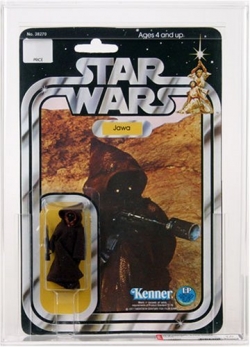
In time for Christmas 1977, Kenner produced the
Star Wars
Early Bird Certificate Package, which basically consisted of IOUs for
the first four action figures to be shipped in early 1978: Luke
Skywalker, Princess Leia, Chewbacca and R2-D2. Many children in 1977
woke up on Christmas morning to find a cardboard envelope in which was
packed a display stand for figures that didn’t yet exist in their
possession, a Star Wars Club Card and a few stickers. The idea was
simple: kids could fill out their certificates with their names and
addresses, put them in the mail and wait. Months later, their set would
arrive along with the pegs to attach them to those display stands Santa
had brought. Kenner had now officially popularized the 3.75” action
figure to an industry standard. In 1977, a sequel to
Star Wars was no longer a question. It was a responsibility to get it done and this time around, adding “
Episode V” was fine by all.
“Merchandising, merchandising! Where the real money from the movie is made.”
- Yogurt

Look
around you. Go ahead, look. I’ll wait. Welcome back. Now, from the
sheets you awaken under to the underwear you wear or refuse to wear
underneath it all, chances are a version of every object in your home
and everywhere you go has existed with the label of
Star Wars
on it at some point in the past few decades. Some may have even spoofed
it. Yes, studios can make money beyond the ticket stub.
Star Wars hit gold in the 1970’s and mastered the art of movie merchandising beyond just a random fad.
Star Wars didn’t invent movie merchandising, but
Star Wars
lucked out into showing Hollywood a volume and variety like it had
never seen before with things like costumes and soundtracks.
Star Wars
matured movie merchandising into the model it is today. I say Lucasfilm
lucked out because of its mass appeal and variety of elements within
that came together to hit the right cord with so many. It was
gender-neutral, age-neutral and even nation-neutral. Just think of other
successful movies, though as popular as they were on the big screen,
which could never reach the same scope in merchandising. Everyone was
surprised, including the filmmakers. That’s a good thing for George
Lucas because if 20
th Century Fox had known that in the
1970’s it was relinquishing any of the merchandising rights to an empire
worth billions, they may have thought twice before signing the contract
they did with George Lucas. Business people tend to do that.

Kenner has produced a massive range of
Star Wars figures and play sets since
Episode IV: A New Hope, and has kept them updated ever since. Not only has
Star Wars
existed in the toy arena, it has reached the outskirts of avid
collectors’ shelves. Every marketing team in the world will suggest
putting “Collect Them All” on a line of products, but how many actually
get people to do it? Just think of how many merchandising products come
and go only to never be around for the next generation. There are a
handful (Disney’s Mickey Mouse, G.I. Joe and Barbie, to name a few) that
have stayed around to the same capacity as the radio has against
television and the internet. Into the 1980’s,
Star Wars too just didn’t seem to go away, even six years after the first movie had been released. People still wanted their share of
Revenge Of The Jedi, which eventually was finalized as
Episode VI: Return Of The Jedi.
But sometime after 1983, there was a long hiccup. The hiccup was that a trilogy was over. Not long after
Return Of The Jedi,
this one directed by Richard Marquand, was released, the marketing
machine’s momentum slowed down significantly and for many years the
Star Wars
toys seemed to disappear out of existence. People seemed to be
complete. Darth Vader was Luke Skywalker’s father, the Galactic Empire
had been defeated and the Force was balanced. The merchandising industry
based on
Star Wars movies no longer had movies to spur its
continuance. Interest waned, but this changed dramatically by the latter
half of the 1990′s when the original trilogy was re-released into
cinemas with additional scenes and updated special effects in 1997. With
this campaign came a new range of toys, which reignited the passion for
Star Wars, but was it all for nostalgia or was something bigger on the horizon? Remarkably, the resurgence in the popularity of
Star Wars had yet to reach its peak. What could match the magnitude of the original trilogy and complete the
Star Wars chronicle? A new trilogy: the prequel trilogy.

Sixteen years after the 1983 premiere of the previous film in the saga,
Episode VI: Return Of The Jedi,
Episode I: The Phantom Menace was set to revive
Star Wars
on May 19, 1999. The wait had culminated to a point in time when visual
effects were beyond anything anyone could have imagined in 1977. This
time, George Lucas was returning to the director’s chair to bring the
film franchise to the finish line. Things were different now than when
he started
Star Wars in the 1970’s. People knew
Star Wars now.
He was no longer a member of the Directors Guild Of America and could
do whatever he wanted with the title sequence that forced him to quit
the guild originally. As an independent filmmaker, he was in his own
league. Beyond the filmmaking, merchandisers were ready for an
onslaught.
Episode I is one of the rare films that may have
actually done well even if it didn’t have a budget for marketing. Other
companies were basically doing it for Lucasfilm and paying them for the
permission to do it.
Merchandising was maxed out for
Episode I. There must have been a surplus, since
Episode II: Attack Of The Clones was visibly scaled back by comparison in hype. The overabundance of
Star Wars simmered down by the time 2002 came along.
Episode I’s campaign was a blitz of a force for the senses. It seemed like everything had
Star Wars
written across it like collectible Pepsi cans with character graphics,
posters and stickers from major restaurants chains, coloring books and
new aisles in big-box stores dedicated only to
Star Wars for everyone devoted to
Star Wars. No matter what type of product you were interested in owning, you could find a
Star Wars-themed version of it in 1999. This time around,
Star Wars
had a primitive version of the internet to boost fanfare even more. The
franchise along with lines of anticipation filled newspapers and
segments on the evening news. The media and the public were overloaded
on midi-chlorians. Even if you didn’t care, you still knew.

I
myself was born in 1988, after the great hype of the original trilogy.
For me, 1999 was my 1977. My dad had just come home from out-of-town and
he took us both to the theater near us to experience
Episode I: The Phantom Menace, part of a franchise new for me and him. On his part, I blame communism. We were one of the many that helped
The Phantom Menace break box-office records and reestablish
Star Wars
in pop culture. We were both one of those that were thrilled about the
podracing. We loved Jar Jar Binks. I know, I bring shame to many fan
clubs of the Old Republic and I’m sure I’ve just been banned from each
one of them for admitting my enjoyment of the bumbling character. My
possessions associated with the movies started with the storybook of
Episode I.
That summer, my parents and I moved across country. In the truck, I
remember the box of Pepsi cans at my feet. I collected them. I wanted
all the characters and I wanted all those cans empty for my shelf. My
first
Star Wars action figure was Watto (how fitting: a
Toydarian) with the Commtech Chip. The Christmas of 1999 was the season
of things like a 3.75” Darth Maul and a 22” Jar Jar Binks that giggled
and shook, and does to this day beside the pit droid time piece. Am I
sentimental about it? You bet. Is it commercialization and
materialistic? Go to hell. It’s damn fun.
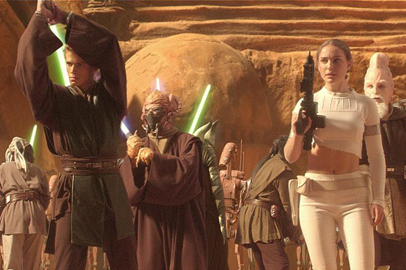
And so,
Episode II: Attack Of The Clones
came and went a few years later, this time with a digitized Yoda rather
than a puppet. Just as Harrison Ford had had trouble pronouncing his
lines during the filming of A New Hope, critics were less than impressed
by the flat dialogue of
Attack Of The Clones. Many also
criticized the new Anakin Skywalker, played by Hayden Christensen. Many
felt it lacked the freshness of previous installments. It did make more
than enough money to be considered financially successful, but adjusted
for inflation,
Episode II is the lowest-performing live-action
Star Wars
film at the North American box-office. It was also not the top-grossing
film of 2002 in the U.S., the first and only time that a live-action
Star Wars film did not have this distinction for its year of release.
Episode III: Revenge Of The Sith
in 2005 officially concluded the events that came to construct the
person known as Darth Vader. The movie was itself another event.
Revenge Of The Sith
became the first Star Wars film in which Anakin Skywalker and the
suited Darth Vader were played by the same actor in the same film. While
Attack Of The Clones didn’t have the same monumental grab or position as the first or last in the prequel trilogy,
Episode III had the advantage of being the last and final
Star Wars movie overall. I can only imagine many saw it that had skipped
Episode II, if only to at least avoid being the one amongst friends that had skipped
Episode III. Some things really do only come but once in time.
“Son, my place is here, my future is here. It is time for you to let go.”
- Shmi Skywalker
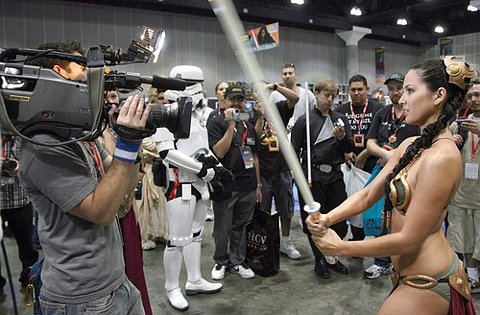
That was then, this is now and what does the future have in store? Now, unlike in the 80’s, the popularity of
Star Wars
has seemed to stick. The Force is as strong as ever with George Lucas.
Lucasfilm’s franchise had its highest toy revenue ever in 2010 for a
year without a movie released in it. According to market research firm
NPD Group, with sales totaling more than $510 million last year,
Star Wars
was able to position itself as the best-selling boys toy license in the
U.S. for the third consecutive year. The animated series has helped
keep the saga in action, but it’s not just the toy industry that has
welcomed the glowing numbers. It’s not hard to find clothing marked with
Star Wars and LucasArts certainly hasn’t abandoned creating videos games for all ages with one thing on their minds:
Star Wars.
The literary industry has also had a steady stream of publications via
galactic trade routes from Coruscant, smugglers via Tatooine and
everywhere in between.
The Lego Star Wars Visual Dictionary
from DK Publishing spent 18 weeks upon its release in the #1 position on
the New York Times Children’s Picture Book Bestseller List.

As for the future, well, that starts this year and many aren’t ready to let go anytime soon.
Star Tours
is set to re-launch its ride at Walt Disney theme parks that debuted
back in 1987, Hasbro and Lego aren’t ditching the bandwagon quite yet,
and it’s pretty safe to say video games aren’t a fad. So as long as
those elements keep pumping along with a variety of other categories and
television productions,
Star Wars so far seems safe from a
great depression. Even theaters haven’t said goodbye to the franchise
entirely. The countdown is on for
Episode I: The Phantom Menace
to kick-start the 3D releases of the space opera in theaters next year.
Just as no one knew what would happen in 1977 after the premiere of
Star Wars, no one knows what will happen with
Star Wars’
popularity in years long off without a supply of new movies. Perhaps
that’s more of a question for the Jedi High Council to ponder. But
there’s one thing you don’t need their help for and that this: the
sci-fi genre on home video will undoubtedly be seeing the heavenly green
glow of greenbacks once
Star Wars: The Complete Saga is unveiled in high-definition.
“Clouded, this boy’s future is.”
-Yoda

Clouded?
Let’s clear the skies, shall we? Get ready for light-speed
internationally beginning September 12. For North America, mark your
calendars: September 16, 2011. That’s the day people’s problems may just
go away. There have been plenty of DVD releases in the past decade, but
now Lucasfilm and 20
th Century Fox Home Entertainment will
be blessing the world with a Blu-ray release of mammoth proportions and
biblical significance for diehards. Expectations are high, but will the
Blu-ray collection disappoint many and be the antichrist? I argue no. I
argue that it will bring balance to the Force. The format has been
around for a while now, so I can only expect George Lucas’ team has put
in quite a bit of effort into this release without just winging it early
on when HD-DVD was still around. Plenty of releases have now proved
some things that work and some things that don’t. But if you want a more
poetic argument for this release not being the antichrist, here it is:
Anakin Skywalker (a.k.a. Darth Vader) and Jesus Christ share quite a few
similarities. Anakin was conceived of the Force without a father.
Anakin spent many years of his life doing good for others and was
betrayed by one of his best friends, although his name wasn’t Judas.
When he came back, he did so as Darth Vader, which could also be similar
to the antichrist returning. Therefore, if you fear the antichrist, he
already came a while ago.

If
you’re thinking this new home video release will just be an entire
repeat, think again, at least partially. Get ready to add another
version of the saga to what has up to now consisted of original
theatrical versions, versions updated with modern CGI and those edited
further for home video. Some visual mistakes left in the movies before
have been removed for the Blu-ray, like a puppeteer’s arms at the edge
of a shot and the inconsistency of a lightsaber’s color across frames.
Some entirely new additions, including a Yoda of CGI, are also on the
way. The digitized Yoda will be inserted into
Episode I: The Phantom Menace to match the rest of the prequel trilogy.
Star Wars will be released in three distinct sets of 6.1 DTS Surround Sound with three unique cover arts to meet the needs of every fan.
Episodes I-III and
IV-VI
will be available as separate collections with three discs in each. But
if you want the prequel trilogy and the original trilogy in one box,
it’s an unheard of thing on home video. At least, it has been until now.
Star Wars: The Complete Saga, a 9-disc set with all six movies
in one package for the first time, will serve as the bible for those of
the Jedi Order around the world.
“I see you have constructed a new lightsaber. Your skills are complete. Indeed, you are powerful, as the Emperor has foreseen.”
-Darth Vader

Rumor is that there are those that have not seen the trilogies, but I doubt those exist that aren’t aware of them.
Star Wars
has been a massive engagement, a timeless and collective discussion
amongst masses. It isn’t bogged down by current events, but that may not
be why people flock to it. No, it may just be because it itself is a
current event. It brings characters from everywhere and anywhere,
location or generation, together on-screen and in front of it. We all
love it when we find the same joy for something we have in ourselves in
someone else. It’s rare for a lot of things, but
Star Wars has
been a common euphoric moment at some point for most that are older than
fifteen. You don’t have to be a sci-fi geek to love
Star Wars. Hotties can romanticize the heroes and mythology of it. It’s possible! A foreigner to toy-lovers may appreciate
Star Wars
by just being enamored by the fairy tale of it all. Ruling at reaching a
video game’s highest score isn’t a requirement to master the concept of
Star Wars. The Force doesn’t discriminate. From date night to boys’ night, the
Star Wars
universe is kind of just cool. Maybe that’s why: it’s constantly
expanding and yet it’s the simple, grandiose memory we all have. It’s
the good ol’ days we don’t have to outgrow because it never seems to get
old no matter how old it gets. The
Star Wars universe didn’t
actually happen in a galaxy far, far away. The phenomenon happened right
around us. And that’s no fiction. May the Force be with you.












